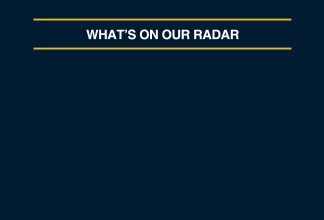What’s Driving the Recent Surge in Gold Prices
Written by The Inspired Investor Team
Published on November 12, 2025
minute read
Share:
Gold has never been an asset that follows the usual market rules, but its latest rally has been nothing short of extraordinary. The precious metal has surged more than 50 per cent over the past year, and hit a record high on October 21,1 even outpacing some tech heavyweights.
Then came the pullback. After adding roughly US$1,000 per ounce between September 1 and October 20,2 gold gave back some of those gains in a matter of days in late October. “No one’s happy the price dropped but I think we’re a little relieved,” says Jeffrey Schok, a Senior Portfolio Manager with RBC Global Asset Management who oversees RBC’s Global Precious Metals Fund. “When you see a rally that’s that quick, you know it’s going to end at some point.”
That doesn’t mean Schok thinks gold has fully run its course. On the contrary, he says there could still be more room for growth. The fundamental drivers supporting gold remain strong, he explains, noting central bank purchases, concerns about government debt and a shift by large institutions towards adding gold to their portfolios.
Here are some of the key things Schok suggests watching with the gold market.
What’s driving interest in gold
Gold has long served as a safe haven for investors in tumultuous times because of its ability to protect against the erosion of purchasing power, Schok says. Government-backed currencies, on the other hand, typically depreciate through inflation and monetary expansion. A basket of goods that would have been bought using gold a century ago still costs roughly the same amount of gold today. The same can’t be said for paper currency, which has lost value compared to gold over time.3
According to Schok, a few different mounting concerns are fueling gold’s resurgence. U.S. debt has climbed to US$38 trillion4 while that country’s debt-to-GDP ratio has hit 125 per cent as of November 6 – double what it was in 2007.5 This, combined with shifting tariff policies and geopolitical tensions, has disrupted global trade and raised questions about institutional sustainability of U.S. debt, in the absence of commitments to either lower the debt or not let it increase constantly. That, in turn, is lowering the value of the U.S.-dollar versus a basket of global currencies. ““Investors are genuinely concerned and are looking toward gold as an alternative,” Schok says.
What makes this rally particularly unusual is that it has defied traditional patterns. Gold often moves in opposition to stocks and weakens when real interest rates and the dollar are strong, but that hasn’t happened this time.
Schock says gold has also caught the eye of many prominent investors who are reconsidering the traditionally popular 60/40 stock-bond portfolio in favour of allocations that include gold. Given the size of some of these potential high-net-worth and institutional investors, the added demand for the yellow metal could be so large that it positively impacts gold prices over time. “The floodgates haven’t really opened yet,” Schok says. “There are organizations and families that have never owned gold before and they’re starting to do the work on it now. That process could take six months, nine months, or a year, but there’s potential ahead [for prices to continue to rise].”
Why central banks are buying in
Another factor distinguishing this rally from past cycles is the role of central banks as major buyers. This shift started with the war in Ukraine, Schok says, when governments watched Russia sustain its economy using gold reserves after being sanctioned and frozen out of the global banking system.
Gold purchases by central banks differ from typical investment behaviour. These banks buy gold for strategic reasons, seeking to diversify their foreign reserves away from the U.S. dollar. Price matters less to them than reducing their reliance on any single currency. China has increased its gold reserves from around 3 per cent to 7 or 8 per cent over the past couple of years,6 Schok says. That still trails the average central bank holding of about 20 per cent, and they could continue to accumulate.
What could slow the surge
While the fundamental drivers of gold’s rise remain strong, Schok says the rally could reverse under certain conditions. If geopolitical tensions were to ease or confidence in U.S. institutions were to improve, the safe-haven demand pushing investors toward gold could weaken. But a resurgence of inflation that forces the Federal Reserve to raise rates rather than cutting them would likely be a bigger threat. A broad equity selloff would also hit gold as investors sell to raise liquidity.
Despite the recent pullback, Schok remains confident in gold, largely because of the mining sector’s evolution over time. During the previous major rally, which ended in 2011, he says gold companies were chasing growth at any cost. This produced an environment of questionable acquisitions and building projects that only worked at inflated prices. The current rally, which started to momentum as early as 2019,7 the industry seems to be showing much more discipline: management compensation is now tied to returns rather than growth and companies are working on projects in phases instead of building everything at once. “Even if the price of gold drops, they’re not in the same kind of high-risk situation,” he says. “The gold sector can afford a much lower price and still do quite well.”
How to get in on gold
If you’re an investor looking to add gold exposure, your options range from physical gold and ETFs that track the metal’s price to shares in mining and exploration companies. Gold stocks as measured by the S&P/TSX Gold Index, have outperformed this year. As of November 6, the index is 107 per cent year-to-date compared to gold’s 51 per cent gain, showing how mining stocks have the potential to amplify gains when gold rises.8 If you’d like to invest in individual stocks, it’s a good idea to research a company’s assets, management and location. You could also invest in mutual funds or ETFs which offer diversified exposure across multiple companies.
Looking to the future, Schok expects the factors driving gold’s rally to persist. Central banks will likely continue to diversify their reserves, investors could keep rethinking traditional portfolio mixes and geopolitical uncertainty is likely to continue. “These are long-term fundamentals for gold,” he says.
- Google Finance, “Gold Continuous Contract”, accessed November 2025
- S&P Capital IQ, accessed November 2025
- World Gold Council, “The International Monetary System and the Canary in the Goldmine”, August 2025
- NBC News, “U.S. national debt reaches a record $37 trillion, the Treasury Department reports”, August 2025
- Fiscal Data, “What is the national debt?”, November 2025
- The Globe and Mail, “How much gold will be enough to diversify China’s reserves?”, September 2025
- Macrotrends, “Gold Prices – 100 Year Historical Chart”, 2025
- Google Finance, “Gold Continuous Contract” – compare function, accessed November 2025
RBC Direct Investing Inc. and Royal Bank of Canada are separate corporate entities which are affiliated. RBC Direct Investing Inc. is a wholly owned subsidiary of Royal Bank of Canada and is a Member of the Canadian Investment Regulatory Organization and the Canadian Investor Protection Fund. Royal Bank of Canada and certain of its issuers are related to RBC Direct Investing Inc. RBC Direct Investing Inc. does not provide investment advice or recommendations regarding the purchase or sale of any securities. Investors are responsible for their own investment decisions. RBC Direct Investing is a business name used by RBC Direct Investing Inc. ® / ™ Trademark(s) of Royal Bank of Canada. RBC and Royal Bank are registered trademarks of Royal Bank of Canada. Used under licence.
© Royal Bank of Canada 2025.
Any information, opinions or views provided in this document, including hyperlinks to the RBC Direct Investing Inc. website or the websites of its affiliates or third parties, are for your general information only, and are not intended to provide legal, investment, financial, accounting, tax or other professional advice. While information presented is believed to be factual and current, its accuracy is not guaranteed and it should not be regarded as a complete analysis of the subjects discussed. All expressions of opinion reflect the judgment of the author(s) as of the date of publication and are subject to change. No endorsement of any third parties or their advice, opinions, information, products or services is expressly given or implied by RBC Direct Investing Inc. or its affiliates. You should consult with your advisor before taking any action based upon the information contained in this document.
Furthermore, the products, services and securities referred to in this publication are only available in Canada and other jurisdictions where they may be legally offered for sale. Information available on the RBC Direct Investing website is intended for access by residents of Canada only, and should not be accessed from any jurisdiction outside Canada.
Explore More

Here’s What Every Canadian Should Know About Estate Planning
Insights from Leanne Kaufman to help you feel more confident as you plan
minute read

3 Things We're Watching This Week
What the Inspired Investor team is watching
minute read

3 Things We're Watching This Week
What the Inspired Investor team is watching
minute read
Inspired Investor brings you personal stories, timely information and expert insights to empower your investment decisions. Visit About Us to find out more.







